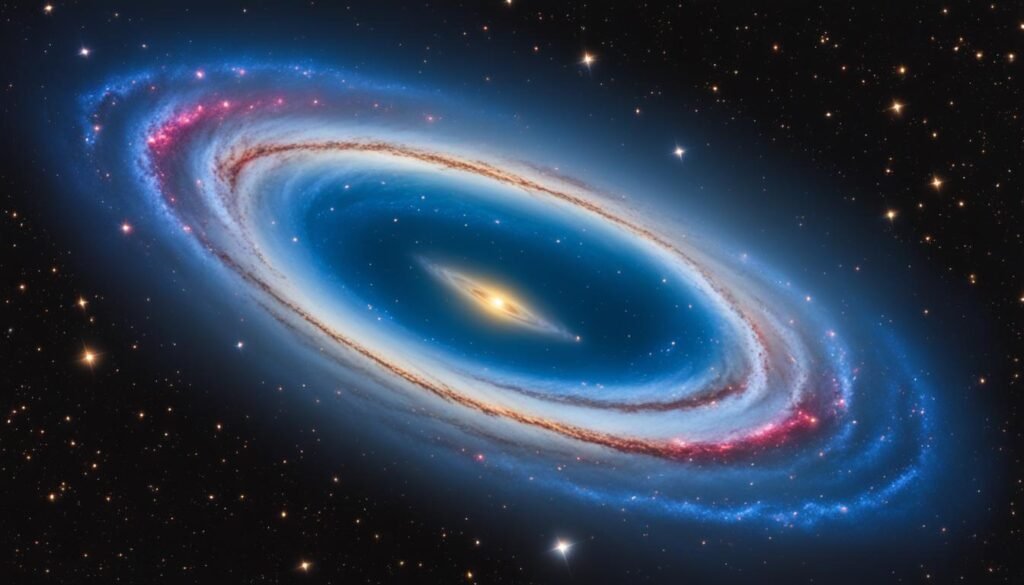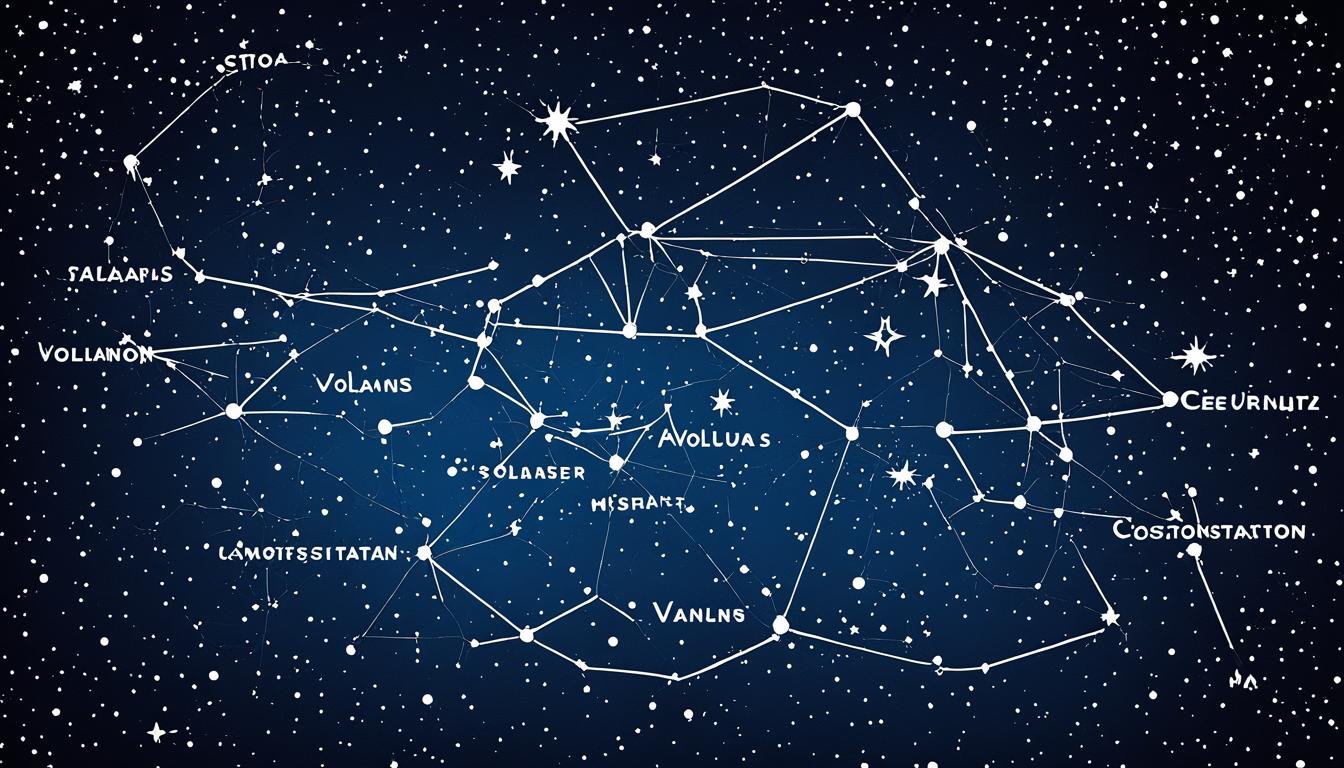| Genitive | |
| Abbreviation | |
| Pronunciation | |
| Main Stars | |
| Brightest Star | |
| Right Ascension | |
| Declination | |
| Sq. Deg. Area | |
| Crosses Meridian | |
| Visible Lat. Range |
Embark on a celestial sojourn through the southern sky with the Volans constellation, a unique fixture among the heavenly bodies. Known to embody the whimsical aspect of a flying fish, the Volans constellation, although devoid of mythological tales, has etched its mark in the annals of astronomy. Crafted by the meticulous observations of Dutch astronomer Petrus Plancius in the 16th century, it soon found a place in Johann Bayer’s star atlas, Uranometria, in 1603. Today, if you glance through the Volans constellation map, you will not only witness the constellation’s modest bearings but also the mesmerizing deep-sky objects it nestles, such as the Lindsay-Shapley Ring and the Meathook Galaxy, which have become some of the initial galactic fascinations for the James Webb Space Telescope.
As you delve into the stars of Constellation Volans, you will uncover an astronomical tableau that is as abundant as it is underappreciated. Let us illuminate the path to understanding this southern constellation that flies across our cosmic ocean.
Key Takeaways
- Discover the origins of Constellation Volans and its depiction as a flying fish, a creation from the age of Dutch explorers.
- Understand the placement and components making the Volans constellation map a must-study for enthusiasts.
- Explore the deep-sky objects, including galaxies like the Lindsay-Shapley Ring that call Volans their celestial home.
- Familiarize yourself with the brightest stars in the constellation, like Beta Volantis, that beacon through the cosmos.
- Learn how Volans became part of the historical account of the cosmos in Johann Bayer’s influential star atlas.
- Recognize the valuable scientific observations made possible by the James Webb Space Telescope within Volans.
An Overview of Constellation Volans
Your journey into the night sky brings you to the Volans constellation facts, encompassing a fascinating region known for its unique celestial features. Nestled in the second quadrant of the southern hemisphere, the Volans constellation blankets an area of 141 square degrees, whispering tales from its Volans constellation history to those who gaze upon its stars.
As you explore this astral domain, you find yourself within viewing range between latitudes +15° and -90°. This locates you perfectly to witness Volans in all its wonder, bordered by the constellations Carina, Chamaeleon, Dorado, Mensa, and Pictor. Known as ‘Flying Fish’ from its Latin roots, Volans constellation information reveals that it is celebrated not just for its beauty but for its significant stellar compositions.
Among its stellar ensemble is Maru, a star carrying a name, and an intriguing discovery of two other stars sheltering planets in their orbit. The brightest star, Beta Volantis, cuts through the cosmic darkness with an apparent magnitude of 3.77, guiding your curious eyes to the mysteries Volans has to offer.
As part of the prestigious Johann Bayer family of constellations, Volans not only offers an insight into the structure of our galaxy but also serves as a testimonial of astronomical history. Let’s take a closer look at some of the stars that make Volans stand out in the celestial tapestry:
| Name | Designation | Apparent Magnitude | Remark |
|---|---|---|---|
| Maru | — | — | One named star in Volans |
| Beta Volantis | β Volantis | 3.77 | The brightest star in Volans |
| — | — | — | Hosts planets in orbit |
Indeed, whether you’re a seasoned astronomer or a casual stargazer, the constellation of Volans offers an exceptional array of spectacles and stories. So, the next time you find yourself under a starlit sky, tilt your gaze southward and marvel at the wonders of Volans, a constellation rich with history, beauty, and a silent promise of continued cosmic discoveries.
A Deep Dive into Volans Constellation Stars
Embark on a celestial journey as you explore the luminaries of the Volans star constellation. Each star holds a unique place in the cosmic ballet, from the brilliant radiance of Beta Volantis to the enigmatic shades of Alpha Volantis. Spanning across the southern hemisphere’s night sky, the Volans constellation stars invite you to witness their grandeur. Let’s meet some of the key players in this astronomical haven.

The Luminosity of Beta Volantis – The Brightest Star
Beta Volantis, the crown jewel of Volans, is an awe-inspiring orange giant star. It is a beacon of light approximately 107.5 light-years from our planet, shining with a luminosity 41 times that of the Sun and holding 1.62 times its mass. Revel in the glow of Beta Volantis, a star whose radiant presence has charted the way for astronomers and stargazers alike.
Unique Characteristics of Alpha Volantis
The allure of Alpha Volantis lies in its spectrum, sporadically reflecting variable metal absorption lines. This metallic line star, located about 125 light-years from Earth, adds a layer of intrigue to the Volans constellation stars. An A-type chemically peculiar celestial body, Alpha Volantis radiates at an apparent magnitude of 4.00, enriching the diversity within this constellation.
The Double Wonder: Gamma Volantis Binary System
At 142 light-years from the Sun, Gamma Volantis presents an astronomical waltz in the form of a binary system. Gamma Volantis pairs an orange giant, Gamma-2 Volantis, with a yellow-white main sequence star, Gamma-1 Volantis. Their duet in the cosmic expanse is separated by mere 14.1 seconds of arc, yet it’s a spectacle to behold for those who turn their gaze skywards with patience and curiosity.
Delta Volantis – A Giant in the Cosmic Sea
Delta Volantis, a distant bright giant, sits roughly 660 light-years away. This star occupies its domain with a F6II stellar classification, emanating an apparent magnitude of 3.97. As a nautical beacon of antiquity, Delta Volantis stands as a testament to the grandeur that the Volans constellation stars are known for.
Exploring the Triple Star System: Epsilon Volantis
The Epsilon Volantis system is a fascinating triumvirate of stars residing about 642 light-years from Earth. This assembly is led by a primary blue-white subgiant that commands the gravitational dance with its two companions, illustrating the complex cosmic relationships that form the mosaic of the Volans constellation.
| Star Name | Distance (Light-years) | Apparent Magnitude | Description |
|---|---|---|---|
| Beta Volantis | 107.5 | 3.77 | Orange giant, brightest star of Volans |
| Alpha Volantis | 125 | 4.00 | Metallic line chemically peculiar star |
| Gamma Volantis | 142 | 3.78 (combined) | Binary system with a orange giant and a main-sequence star |
| Delta Volantis | 660 | 3.97 | Yellow-white bright giant |
| Epsilon Volantis | 642 | 4.35 (primary) | Triple star system with a blue-white subgiant |
As you continue to gaze at the stars of the Volans constellation, remember that each point of light is a story, a history, and a spectacle all on its own. The universe beckons your curiosity and marvels at your wonder, offering a glimpse into the vastness of its beauty, one star at a time.
Unlocking the Mysteries of Deep Sky Objects in Volans
As you cast your gaze towards the Volans constellation, you embark on a journey to unravel the enigmas of its deep sky objects. The celestial masterpieces within this region are not just awe-inspiring sights but also key to understanding galactic interactions and the cosmic lifecycle of stars.
The Galactic Phenomenon – Lindsay-Shapley Ring
At the heart of Volans lies the Lindsay-Shapley Ring, a galactic relic symbolizing the tumultuous aftermath of interstellar collisions. This lenticular galaxy showcases a galactic ring that spans an impressive 150,000 light-years. Within this ring, new stars are being birthed, igniting the space with the vibrant light of hot, blue stars, revealing the dynamic nature of our universe.
NGC 2397: A Spiral Galaxy Unraveled
One standout cosmic structure in Volans is NGC 2397, a spiral galaxy that exhibits the graceful dance of stellar creation. It’s wrapped in a shroud of mystery, with spindly arms that wind around a seasoned core of elder stars—visible evidence of the continuum of star formation and the ever-evolving galactic story.
NGC 2442: The Intriguing Meathook Galaxy
The Meathook Galaxy (NGC 2442), so named for its asymmetrical and hooked appearance, hints at the gravitational struggle with a cosmic neighbor unseen to our eyes. Its twisted form, located approximately 50 million light-years from Earth, offers a captivating glimpse into the forces that shape galaxy structures throughout the cosmos.

To fully appreciate the grandeur of Volans’ deep sky objects, let’s compare the Lindsay-Shapley Ring and its neighboring galaxies, NGC 2397 and NGC 2442, with some intriguing characteristics.
| Feature | Lindsay-Shapley Ring | NGC 2397 | NGC 2442 (Meathook Galaxy) |
|---|---|---|---|
| Distance from Earth | 300 million light-years | 60 million light-years | 50 million light-years |
| Characteristic | Unbarred lenticular galaxy with a starburst ring | Spiral galaxy with prominent arms | Irregular spiral with asymmetric, hook-like arms |
| Significance | Indicator of galactic collision and star formation | Site of active star formation at the edges | Shows the impact of gravitational interaction |
| Notable Event | – | Supernova SN 2006bc | Documented by John Herschel |
Armed with the knowledge of these incredible objects, your exploration of Volans and its galactic inhabitants is now steeped in deeper understanding and appreciation for the cosmic ballet that unfolds in the vast expanse of the night sky.
The Rich History and Lore Surrounding Volans
Embarking upon the celestial journey through the Volans constellation history, your mind may venture back to a time when the world’s oceans were maps yet to be drawn. It was during this age of adventure and discovery that the Volans constellation glided into the night sky. Unveiled by Dutch navigators, who first used the stars to navigate the unknown southern seas, Volans now stands as a symbol of humanity’s enduring quest to chart the cosmos.
Unlike many other constellations which are steeped in mythology, Volans constellation lore veers from tradition, having no ties to ancient myths. Instead, its story is penned in the annals of maritime history and science—a true testament to the human spirit’s aspirations and cerebral triumphs. It was Johann Bayer, a prominent figure in the field of uranography, who brought widespread attention to Volans through his stellar compendium, Uranometria, and thus, it took its place among the stars.
- Johann Bayer’s Uranometria – The Introduction of Volans to the World
- Maritime Origins – A Constellation Born from Navigational Needs
- A Constellation Without Myth – Signifying Scientific Progress
Your gaze upon the night sky is not just a moment of wonder but also a reflection upon the remarkable history and discoveries that have been made. As you look up at the stars of Volans, remember that you are witnessing a legacy of the 16th-century explorative spirit and human curiosity that continues to thrive—an integral thread in our ever-expanding cosmic map.
| Feature | Significance | Historic Representation |
|---|---|---|
| Introduced by Dutch Navigators | Integral for Southern Hemisphere navigation | Scientific advancements in the Age of Exploration |
| Popularized in Uranometria | Widely recognized star atlas inclusion | Early efforts in celestial cartography |
| Volans – ‘Flying Fish’ | Representation of a tropical gliding fish | Humanity’s connection and interpretation of nature |
Finding Volans: A Stargazer’s Guide to Constellation Location and Visibility
As you venture out under the night sky, your quest to locate the elusive Volans constellation begins. This constellation unravels its twinkling form between the latitudes of +15° and -90°, situated squarely in the SQ2 quadrant of the southern hemisphere. Prime visibility of Volans peaks in March at around 9 PM, offering a cosmic spectacle for those who seek out its stars. The challenge and allure of spotting Volans lie in its small stature, but that only adds to the celestial thrill of tracing the outline of the Flying Fish against the expansive backdrop of the universe.
For amateur astronomers and seasoned stargazers alike, understanding the Volans constellation map is paramount. It’s key to anticipate where the constellation rises and descends, ensuring a rewarding viewing experience. Below, a visual aid is provided to offer a clearer perspective on how you might align your gaze and equipment to best witness Volans’ celestial journey throughout the night.
- Find a dark location away from city lights to increase your chances of spotting fainter stars.
- Allow your eyes to adjust to the dark for at least 20 minutes before beginning your search for Volans.
- Use a star chart or stargazing app tailored to the southern hemisphere to guide you towards the constellation’s location.
- Binoculars can be helpful to resolve more stars within the constellation, while a telescope may reveal some of its deep-sky objects.
Remember, the quest to find Volans rewards both patience and preparation. As the vibrant heart of celestial navigation, every star charted on the Volans constellation map adds another story to the grand atlas of our skies. Embrace the stillness of the night and let the visibility of Volans guide you through an adventure across the cosmos.
The Neighboring Constellations and the Family of Johann Bayer
As you gaze upon the southern night sky, the constellation Volans serves as a vibrant centerpiece amidst a gathering of its celestial neighbors. These adjacent constellations, each with their distinct features and tales, form a vibrant tapestry against the cosmos. Let’s embark on a journey through these neighboring clusters of stars, unveiling the broader narrative they contribute to the nocturnal heavens.
Mapping the Cosmic Neighborhood: Adjacent Constellations
The artistry of the night sky around Volans is enriched by the presence of the surrounding constellations of Carina, Chamaeleon, Dorado, Mensa, and Pictor. Each constellation boasts its own unique allure:
- Carina: With the famed keel of the ship Argo Navis, Carina navigates through the southern sky with features like the resplendent Canopus, the second-brightest star we can observe.
- Chamaeleon: Known for its variable stars, Chamaeleon cloaks itself in the depth of the southern celestial sphere, symbolizing the adaptable reptile.
- Dorado: Home to the Large Magellanic Cloud, Dorado is a goldfish glimmering in the sky river, offering a gateway to galaxies beyond our own.
- Mensa: Named after Table Mountain, Mensa embraces the south celestial pole, offering a stellar plateau from which to survey the skies.
- Pictor: Depicting an artist’s easel, Pictor is a constellation that paints a picture of celestial beauty dotted with star clusters and galaxies.
With this assembly,
Volans neighboring constellations
provide a panoramic vista for your nocturnal observations.
The Legacy of Bayer’s Constellations: A Collective Inheritance
The constellation Volans is a proud member of the revered Johann Bayer family of constellations; a historical grouping outlined by the German astronomer in his influential 17th-century star atlas, the Uranometria. This cosmic collection, which includes notables like Apus, Dorado, and Tucana, represents a significant legacy, shaping our understanding of the night sky. Bayer’s work laid down the groundwork for the standardized celestial map that you, the modern stargazer, rely upon to navigate the stellar sea. As you admire the Volans constellation stars, remember that they are part of a grand historical design, a cosmic inheritance passed down through the annals of astronomical discovery.
Notable Exoplanets and Future Discoveries in Constellation Volans
As you gaze upon the stars, the constellation Volans offers more than historical insight and celestial beauty. It serves as a frontier for exoplanetary discoveries that continue to fascinate and challenge our understanding of the cosmos. Among these, the star HD 76700 proposes an intriguing subject of study due to its accompanying exoplanet, signifying the dynamic universe that extends beyond our Solar System into the sprawling skies of Volans.
A Glimpse into a Distant World: HD 76700’s Exoplanet
The discovery of an exoplanet in orbit around HD 76700 represents a remarkable step in the field of astronomy, specifically within the context of Volans constellation exoplanets. This celestial body, with a mass about a quarter that of Jupiter, completes an orbit in just under four days, showcasing the diversity of planetary systems. Such findings within the Volans constellation not only pique our curiosity but also deepen our comprehension of the galaxy’s architectural variety.
Prospects of New Discoveries: Advances in Exoplanetary Research
In the realm of exoplanetary research, technology advances rapidly, fueling the anticipation of new planets waiting to be uncovered. The Volans constellation exoplanets could hold secrets to questions we haven’t even thought to ask yet. Driven by scientific progress and relentless curiosity, astronomers continue the quest, leveraging cutting-edge observation techniques that promise to broaden our horizons and enrich our understanding of spatial phenomena. Your look into the night sky might just coincide with the next groundbreaking discovery within the spectral confines of Volans.
FAQ
What does the Volans constellation represent, and who discovered it?
The Volans constellation represents a flying fish and was conceived by Dutch astronomer Petrus Plancius in the late 16th century. It was incorporated into Johann Bayer’s star atlas, Uranometria, in 1603.
What are the coordinates for locating the Volans constellation in the sky?
Constellation Volans is located in the second quadrant of the southern hemisphere (SQ2) and is visible at latitudes between +15° and -90°. It occupies a 141 square degree region of the sky.
What is the brightest star in Constellation Volans and what are its characteristics?
The brightest star in Constellation Volans is Beta Volantis, with an apparent magnitude of 3.77. It is an orange giant located approximately 107.5 light-years from Earth and has 41 times the luminosity and 1.62 times the mass of the Sun.
Are there any notable deep-sky objects within Volans?
Yes, there are several notable deep-sky objects in Volans, including the Lindsay-Shapley Ring, an unbarred lenticular galaxy; NGC 2397, a spiral galaxy; and the Meathook Galaxy (NGC 2442), known for its asymmetrical shape.
Does the Volans constellation have any mythological tales associated with it?
No, the Volans constellation is unique in that it does not have any myths associated with it. It was introduced by navigators during the age of exploration as a means to chart unknown southern skies.
When is the best time to view the Volans constellation?
The best time to view the Volans constellation is in March around 9 PM. However, it can be viewed at different times throughout the year due to the Earth’s rotation.
Which constellations border Volans?
Volans is bordered by the constellations Carina, Chamaeleon, Dorado, Mensa, and Pictor, each contributing to the rich narrative of the southern sky.
How does Volans fit into the family of constellations named by Johann Bayer?
Volans is part of the Johann Bayer family of constellations, which includes other southern constellations like Apus, Chamaeleon, Dorado, and Tucana. These constellations were designated by Bayer in the early 17th century and continue to influence modern star charts.
What exoplanets have been discovered in the Volans constellation?
A notable exoplanet discovered in the Volans constellation is orbiting the star HD 76700. This exoplanet has a mass 0.233 times that of Jupiter and orbits its host star every 3.97097 days.
What future discoveries might we expect in Constellation Volans?
With advances in observational technologies, astronomers anticipate discovering more exoplanets and deep-sky objects in Volans, further enriching our understanding of this star constellation and its place in the cosmic landscape.






